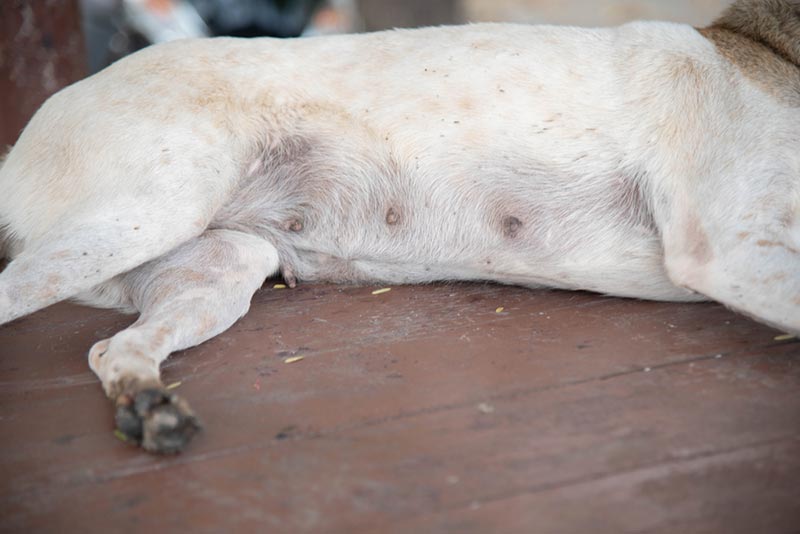Mouth Disease in Cats: Signs, Causes & Treatments (Vet Answer)
By Dr. Kim Podlecki, DVM (Vet)
Updated on

Click to Skip Ahead
Cats can suffer from numerous diseases of the mouth. It’s impossible to discuss all of the mouth diseases we see in cats in one article so we will just focus on stomatitis. It’s important to note that different mouth diseases in cats can appear similar, especially when the problem is just starting. Therefore, after reading this article, if you think your cat has stomatitis, it’s still important to see a veterinarian so that an accurate diagnosis and appropriate treatment plan can be made. Your veterinarian will also be able to rule in or out other oral diseases not discussed in this article.
What Is Stomatitis?
Stomatitis is inflammation of the mucous membranes of the mouth. The mucous membranes include the gums and gum tissue. In other words, the normally pink or pigmented tissue that goes along both the upper and lower jaw, around and associated with all of the teeth. There is also mucous membrane tissue associated with the tongue and palate (roof of the mouth), and the back of the oropharynx.
In cats, there is varying severity of stomatitis. Sometimes it’s just the mucous membrane tissue along the teeth (in other words, the gumline). However, this can progress in some cats to include inflammation of portions of the tongue, lips, palate and the gums.

What Are the Signs of Feline Stomatitis?
The appearance of feline stomatitis can vary. Sometimes, there is just redness, swelling and inflammation of the gum tissue. Typically, this will start at the gumline, or the gum tissue that is directly adjacent to the teeth. All of the teeth may be affected, or just portions of either the upper or lower jaw. As the disease progresses, signs may progress to having more appreciable swelling, redness, and even bleeding of the gums.
In severe cases, all mucous membranes are inflamed. This means that areas along the gumline, the tongue, the roof of the mouth (the palate), and the back of the throat (the oropharynx) can all be affected. The signs would be severely red, irritated, inflamed tissue. Many times the affected areas will be bleeding and may also have an odor.
Feline stomatitis can be very painful, with cats often having a decreased appetite, drinking less than normal, or pawing at their mouth due to the discomfort. You may notice blood in your cat’s water bowl, or they may only eat canned food because it’s more comfortable for them. Oftentimes it’s very painful for cats to open their mouth when they have stomatitis. You may notice them not “meowing”, vocalizing as if in pain when they try to open their mouth to eat and/or yawn, excessive drooling, and avoiding pets or contact with owners. Many cats will stop grooming themselves due to the pain.

What Are the Causes of Stomatitis?
The exact cause of feline stomatitis is unknown. There are some cats that will have underlying viral diseases such as herpes virus, calicivirus, FeLV, or FIV. Many believe that these may be the catalysts to developing stomatitis. However, we have many cats affected with one or many of those viruses at the same time that do not develop stomatitis.
Underlying bacterial or fungal infections are also possible, though not highly documented. Oftentimes many veterinarians will at first complete a good, anesthetized dental cleaning on your cat. This includes using specialized dental tools to remove all visible tartar and plaque, and to get under the gumline to remove all of the bacteria and build-up. If your cat still has stomatitis following this procedure, then it’s likely not from an underlying dental problem and/or bacteria associated with the gums.
The most accepted theory is that there are one or more auto-immune responses occurring that cause the inflammation. In other words, the body reacts to a normal substance, tissue, material, or cell in the body abnormally. The body will view these typically normal things as foreign, mounting a severe inflammatory response. No single underlying cause has yet to be found for being the cause of feline stomatitis.
How Do I Care for a Cat With Stomatitis?
If you are suspicious that your cat has stomatitis, you should absolutely make an appointment with your veterinarian. This will ensure that your cat is both appropriately diagnosed, and also prescribed appropriate medications.
While you are awaiting your appointment, feed your cat only soft/canned food, or soften their kibble with water. This will make it easier and less painful for your cat to eat. Some cats will also do well with plain baby food or pureed food that they can just lap up and swallow.
Your cat will need to be on good pain medications. There are a lot of good options out there for cats nowadays, but it’s important to know that all of them need to be prescribed by a veterinarian. There are no over-the-counter (OTC) pain medications that are safe to give your cat, and many can be toxic or fatal. Your veterinarian can speak to you about pain medication options and how they are administered. Also ask your veterinarian about compounding pain medications. This means that a pharmacy can make meds into flavored solutions, tablets, or capsules that may be easier to give your cat.
Many cats will also be prescribed an antibiotic to clear up any underlying or secondary bacterial infections associated with the stomatitis. Like the pain medications, there are many different types and formulations of antibiotics that your cat may do well on.
As mentioned above, a thorough, anesthetized dental cleaning is typically recommended. This is to ensure that all of the plaque, tartar, and bacteria are removed from both the surface of the teeth, and underneath the gum line. Unfortunately, many cats with stomatitis may need multiple dental extractions, some may even need all of their teeth removed.
Some cats do well on anti-inflammatories or other immunosuppressive medications. Each case is different, and your veterinarian will recommend treatment based on your individual cat’s current and past health history.

Frequently Asked Questions (FAQ)
Will Regular Tooth Brushing Cure Stomatitis?
Unfortunately, not. While underlying dental disease (plaque, tartar, gingivitis, and bacteria) may contribute, it’s not the cause of stomatitis. Cats that have dental disease and stomatitis should absolutely have their dental disease addressed as this may make stomatitis worse. But brushing your cat’s teeth may actually be extremely painful for your cat if they have stomatitis.
How Long Is Treatment?
Treatment for cats with stomatitis is lifelong. This disease is not one that can be cured. Your cat will likely have medications long-term, and will need regular dental care long-term as well to help control the inflammation, signs, and pain. You will absolutely need to be committed to treating your cat for the rest of their life.
Will My Cat Die from Stomatitis?
While stomatitis itself is not fatal, prolonged complications may lead to death at a younger age. If your cat is unable to eat due to pain, then they may lose significant weight. The same goes for decreased water intake. If your cat’s pain, inflammation, and mouth comfort cannot be well controlled, even with dental extractions, many owners may choose to proceed with humane euthanasia due to their cat’s quality of life being severely affected.
Conclusion
Feline stomatitis is inflammation of the mucous membranes of the mouth. The gum tissue along the teeth, back of the throat, and often portions of the tongue and palate may be affected. Your cat’s mucous membranes will be severely red, inflamed, and sometimes bleeding. Stomatitis is extremely painful, and you may notice your cat not wanting to eat, pawing at their mouth, or vocalizing when opening their mouth. Your cat will need to be under the care of a veterinarian for appropriate pain medications, antibiotics, and often dental extractions. Unfortunately, feline stomatitis is a lifelong disease that you will need to be committed to treating in your cat for years to come. While the disease is not fatal, it may lead to a significantly decreased quality of life if not well controlled, and many cats with the disease will be euthanized.
Featured Image Credit: mojahata, Shutterstock














